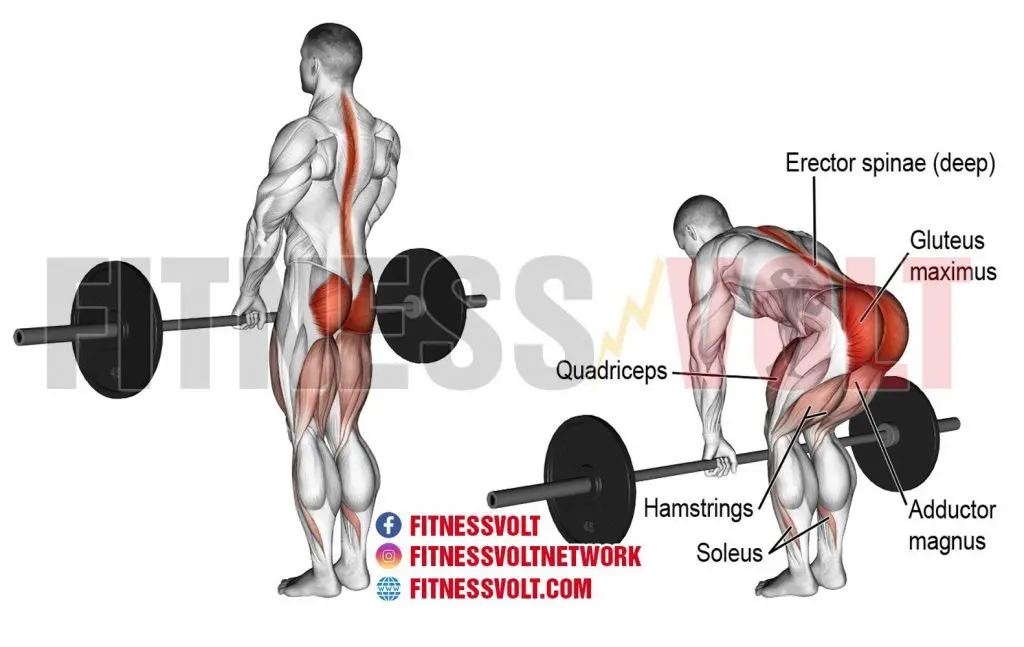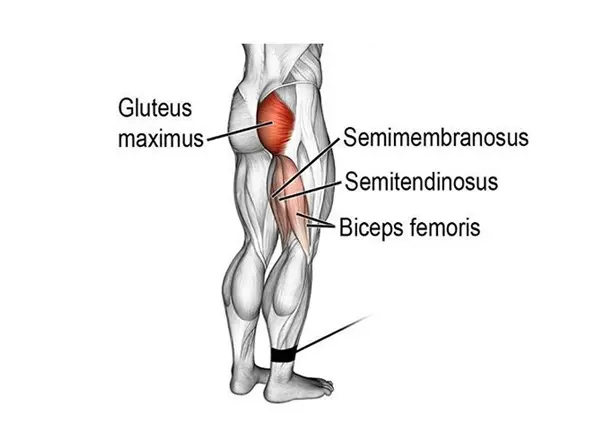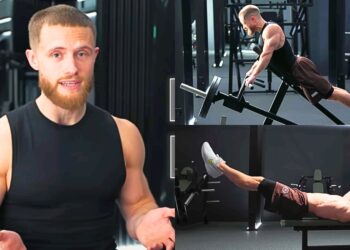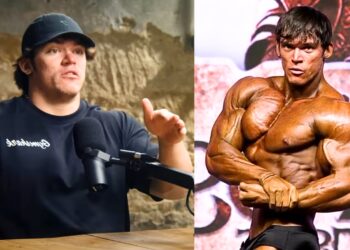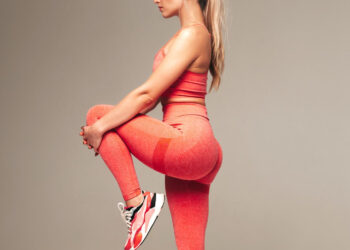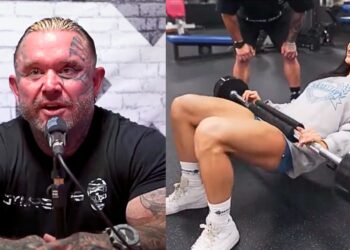Long periods of sitting keep your glutes in a stretched position for an extended duration. This causes the muscles at the front of your hips, the hip flexors, to shorten and tighten. In response, sitting too much also stretches and weakens the opposing muscles – the hip extensors.
Weak hip extensors can result in several unwanted side effects, including:
- Lower back pain
- Hip joint inflammation and pain
- Poor athletic performance
- A soft, flabby butt
As a personal trainer with over 35 years of experience, I ensure all my clients train their hip extensors, and the best way to do this is with the best hip extension exercises.
The best part is that some of these exercises can be done at home and require no equipment. Others are best done in the gym. In this article, I share the eight best hip extension exercises you can do for optimal results.
Recent Updates: On July 20, 2024, Fitness Volt’s Senior Editor Vidur Saini (American Council on Exercise-CPT) updated the article and added actionable expert tips throughout the piece to improve the reader experience. Level Up Your Fitness: Join our 💪 strong community in Fitness Volt Newsletter. Get daily inspiration, expert-backed workouts, nutrition tips, the latest in strength sports, and the support you need to reach your goals. Subscribe for free!
8 Best Hip Extension Exercises
Are you unsure which exercises are best for strengthening your hip extensor muscles? No problem; here are eight of the best moves for achieving this crucial training goal.
- Quadruped Hip Extension
- Hip Thrusts
- Standing Cable Hip Extension
- Pilates Swimming
- Total Hip Extension Machine
- Stability Ball Hip Extension / Leg Curls
- Romanian Deadlifts
- Kettlebell Swings
1. Quadruped Hip Extension
| Sets & Reps | 3 x 10-15 |
| Equipment Needed | None (mat optional) |
| Target Muscles | Gluteus maximus, hamstrings |
This bodyweight glute and hamstring exercise is ideal for home use and is also easy on your lower back. It’s a good place to start if you need a beginner hip extension exercise that you can do anywhere and at any time.
Saini explains that this exercise is often overlooked, but it’s a fantastic way to isolate the gluteus maximus and improve hip stability, especially for those new to training.
How to do it:
- Kneel on all fours so that your shoulders are directly over your hands and your knees are directly below your hips. Brace your abs and make sure your lower back is slightly arched. Tuck your chin in so your neck is neutral.
- Extend one leg back and up, keeping your knee bent to 90 degrees throughout. The sole of your foot should face the ceiling, and your thigh should finish up parallel to the floor.
- Do not allow your hips to twist, and do not hyperextend your lower back.
- Lower your leg and repeat for a prescribed number of reps.
- Swap sides and repeat.
Pro Tip: To make this exercise a little harder, wear ankle weights or hold a dumbbell behind your knee.
Benefits:
- Simple and effective
- Ideal for beginners
- No equipment required
| Difficulty | Beginner |
| Progression | Resistance band quadruped hip extension |
| Regression | Glute bridge |
2. Hip Thrusts
| Sets & Reps | 3 x 8-12 (or 3 x 15-20 for lighter weight/bodyweight) |
| Equipment Needed | NA |
| Target Muscles | Gluteus maximus, hamstrings, adductor magnus |
Hip thrusts are a popular hip extensor exercise that can be done using nothing more than your body weight for resistance. They can also be made harder by adding a barbell. You can also do hip thrusts with a booty band around your knees to increase glute activation.
“The hip thrust is the king of glute activation,” says Saini. No other exercise comes close to recruiting the glutes as effectively, making it essential for both strength and hypertrophy goals.
How to do it:
- Lie on your back with your legs bent and feet flat on the floor. Place your arms on the floor by your sides.
- Drive your feet into the floor and push your hips up toward the ceiling. Your knees, hips, and shoulders should form a straight line.
- Lower your butt back down to the floor and repeat.
Pro Tip: Make this exercise harder by holding a weight on your hips, using one leg at a time, or placing your feet or shoulders on a step or bench to increase your range of motion.
Benefits:
- No lower back strain
- Suitable for home exercisers
- Easy to make harder for continued progress
| Difficulty | Intermediate |
| Progression | Barbell hip thrust, single-leg barbell hip thrust, band-resisted hip thrust |
| Regression | Glute bridge |
3. Standing Cable Hip Extension
| Sets & Reps | 3 x 12-15 |
| Equipment Needed | Cable machine with ankle cuff |
| Target Muscles | Gluteus maximus, hamstrings |
This exercise involves using a low cable machine paired with an ankle cuff. It provides an excellent way to progress your hip extensor workouts because you can increase the weight as you get stronger.
Saini highlights that this exercise offers a unique advantage by providing constant tension throughout the movement.
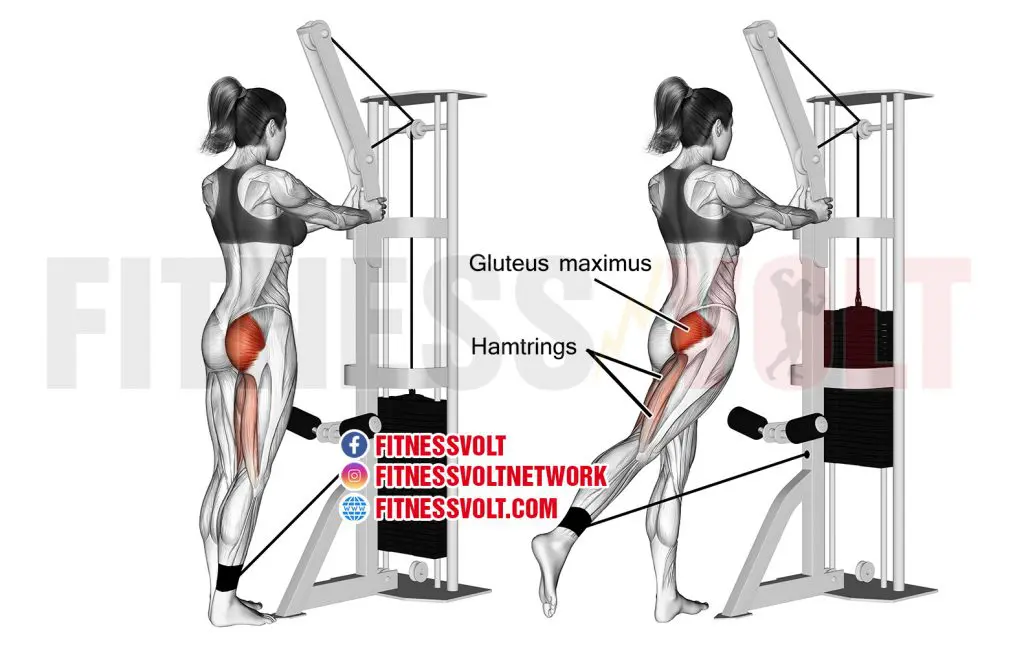
How to do it:
- Attach an ankle cuff to your ankle. Fix a low cable to the cuff. Stand facing the cable machine with your arms braced for balance. Bend your non-working leg for extra stability.
- Extend your hip out behind you, keeping your leg slightly bent throughout.
- Return to the starting position and repeat.
- The further away you stand from the pulley, the greater your range of motion, and the more demanding this exercise will be.
Pro Tip: Maintain a slight posterior pelvic tilt (tuck your tailbone under) throughout the movement. This will help prevent your lower back from taking over and ensure your glutes are doing the work.
Benefits:
- Allows for more resistance and a more intense workout
- Work one leg at a time for more even muscular development
- Involves more balance
| Difficulty | Beginner |
| Progression | Smith machine hip extension |
| Regression | Bodyweight hip extension (standing or kneeling) |
4. Pilates Swimming
| Sets & Reps | 3 x 30-60 seconds (hold) |
| Equipment Needed | Mat (optional) |
| Target Muscles | Gluteus maximus, hamstrings, erector spinae (lower back) |
This is another straightforward but effective hip extension exercise. Taken from Pilates, this move is ideal for home exercisers as you don’t need anything other than a mat to do it.
While it looks simple, Pilates swimming is incredibly challenging for the posterior chain (glutes, hamstrings, and lower back), making it a great way to build endurance and stability.
How to do it:
- Lie on your front with your arms extended out in front of you.
- Lift your arms and legs a few inches off the floor and kick like you were swimming. Lift your opposite arm and leg.
- Continue until you can feel your hip extensors starting to fatigue.
Pro Tip: Engage your core to stabilize your spine and prevent arching your lower back.
Benefits:
- A good exercise for beginners
- No equipment required
- A useful lower back strengthening exercise
| Difficulty | Intermediate |
| Progression | Increase hold time, flutter kicks with alternating arm raises |
| Regression | Bird dog exercise, single-leg glute bridge hold |
5. Total Hip Extension Machine
| Sets & Reps | 3 x 10-15 |
| Equipment Needed | Hip extension machine |
| Target Muscles | Gluteus maximus, hamstrings |
Also known as a four-way hip machine, this gym staple is an excellent way to work your hip extensors without worrying too much about balance. With no cuffs or cables to worry about, the setup and performance of this exercise are very straightforward.
Saini underlines that the hip extension machine is a valuable tool for isolating the glutes and hamstrings, making it ideal for those who struggle to activate these muscles during other exercises.
How to do it:
- Adjust the lever arm so that it’s about hip height. Standing sideways on, place your nearside leg over the movement arm so that the pad is directly behind your knee. Hold the handle for balance.
- Drive your leg down and back against the resistance offered by the machine. Extend your hip as far as you can without hyperextending your lower back.
- Return to the starting position and repeat.
- Do the same number of reps on each leg.
Pro Tip: Don’t rely solely on momentum to move the weight. Instead, focus on a controlled eccentric (lowering) phase, resisting gravity as you return to the starting position.
Level Up Your Fitness: Join our 💪 strong community in Fitness Volt Newsletter. Get daily inspiration, expert-backed workouts, nutrition tips, the latest in strength sports, and the support you need to reach your goals. Subscribe for free!
Benefits:
- Allows you to train with heavy weights
- A good exercise for runners
- An easy-access exercise as it doesn’t involve lying on the floor
| Difficulty | Beginner |
| Progression | Increase weight |
| Regression | Cable variation |
6. Stability Ball Hip Extension / Leg Curls
| Sets & Reps | 3 x 12-15 |
| Equipment Needed | Stability ball |
| Target Muscles | Gluteus maximus, hamstrings |
This hip extension exercise also involves knee flexion, making it a hamstring twofer. It is performed using a stability ball but can also be done using a TRX.
The ball’s instability adds an extra challenge to this exercise, forcing the core and stabilizer muscles to work harder, leading to improved balance and coordination alongside glute and hamstring strength, says Saini.
How to do it:
- Lie on your back with your legs straight and your calves and feet resting on a stability ball. Lift your butt off the floor, so your body forms a straight line.
- Push your hips up and simultaneously bend your legs, rolling the ball in toward your butt.
- Extend your legs and, without lowering your butt back to the floor, repeat for the prescribed number of repetitions.
Pro Tip: Ensure your hips stay elevated and aligned with your shoulders and knees throughout the movement. This will help maintain stability and prevent your back from arching.
Benefits:
- Easy on your lower back
- Good for balance and coordination
- A useful core exercise
| Difficulty | Intermediate |
| Progression | Single-leg stability ball hip extension/leg curl, hamstring curl machine |
| Regression | Glute bridge on a stability ball, single-leg glute bridge |
7. Romanian Deadlifts
| Sets & Reps | 3 x 6-8 (focus on heavier weight) |
| Equipment Needed | Barbell (or dumbbells) |
| Target Muscles | Gluteus maximus, hamstrings, erector spinae (lower back) |
The Romanian deadlift is an excellent hip extension exercise. However, with this exercise, instead of moving your legs, your legs remain stationary, and your upper body moves instead. Make no mistake, this is still a hip extension movement.
Saini underlines that the RDL is a staple for building strong hamstrings and glutes, which is crucial for athletic performance and injury prevention.
How to do it:
- Stand with your feet about hip-width apart and with a barbell in your hands. Use an overhand or mixed shoulder-width grip. Bend your knees slightly and then keep them rigid for the duration of your set. Lift your chest, pull your shoulders down and back, and brace your abs.
- Push your butt back and hinge forward from your hips. Lean over and lower the bar down the front of your legs. Do not allow your lower back to round. Descend as far as your flexibility allows.
- Stand up straight, but don’t lean back.
- This exercise can also be done using dumbbells.
Pro Tip: Initiate the movement by pushing your hips back, not bending your knees. Keep the bar close to your body throughout the entire lift to maintain tension on the hamstrings and glutes.
Benefits:
- A good exercise for building strength and muscle mass
- An excellent deadlift assistance exercise
- Involves the entire posterior chain
| Difficulty | Advanced |
| Progression | Deficit Romanian deadlifts, banded Romanian deadlifts |
| Regression | Good mornings |
8. Kettlebell Swings
| Sets & Reps | 3 x 15-20 |
| Equipment Needed | Kettlebell |
| Target Muscles | Gluteus maximus, hamstrings, core, shoulders |
Kettlebell swings are an explosive movement that, like Romanian deadlifts, involves moving your body while your legs remain mostly stationary. It’s a fun and effective hip extension exercise that will also raise your heart rate.
The kettlebell swing works nearly every muscle in the body, emphasizing the posterior chain, making it a highly efficient way to build strength and burn calories,” Saini says.
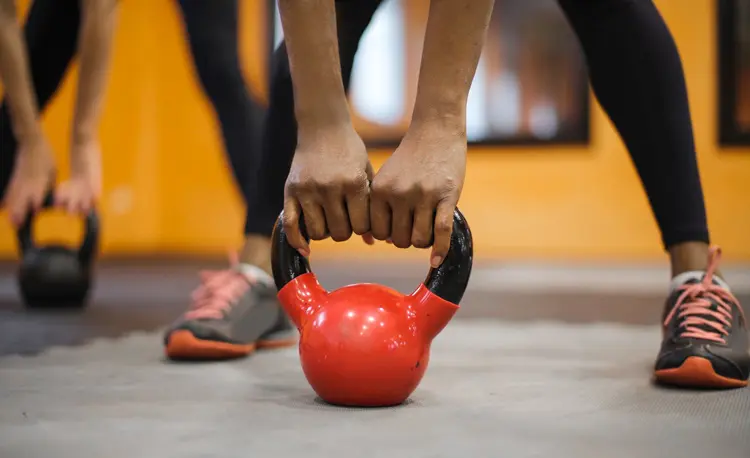
How to do it:
- Hold a kettlebell with two hands in front of your hips. Stand with your feet shoulder-width apart, knees slightly bent but rigid.
- Push your hips back and lean forward, lowering the weight between your knees.
- Drive your hips forward and use this momentum to swing the weight up to shoulder height. Keep your arms straight, and your shoulders pulled down and back. Do not round your lower back.
- Swing the weight back down and then immediately fire off another rep.
- You can also do swings with a dumbbell.
Pro Tip: The power of the swing comes from the explosive hip hinge, not the arms.
Benefits:
- A fast-paced exercise that is fun to do
- Good for cardio, conditioning, and fat-burning
- An excellent exercise for the entire posterior chain
| Difficulty | Intermediate |
| Progression | Single-arm kettlebell swing |
| Regression | Cable pull-through |
Best Hip Extension Workout For Maximizing Hypertrophy
Perform the following workout once weekly for the best results:
| Exercise | Sets | Reps | Rest |
| Hip Thrusts | 3 | 8-12 | 60-90 sec |
| Quadruped Hip Extension | 3 | 10-15 per leg | 30 sec |
| Romanian Deadlifts (RDLs) | 3 | 6-8 | 60-90 sec |
| Standing Cable Hip Extension | 3 | 12-15 | 30-60 sec |
| Kettlebell Swings | 3 | 15-20 | 60-90 sec |
Muscles Worked During Hip Extension
Several muscles are involved in hip extension. Knowing a little more about these muscles will help you identify the best hip extension exercises, and also avoid those exercises that are not so effective.
For clarity, hip extension is a movement during which your femur or thigh bone moves backward, such as when you stand up after sitting in a chair or drive your leg back while running up a hill. The muscles responsible for this movement are:
Gluteus Maximus
Known as your glutes for short, this is the largest muscle in your body, and also your most powerful hip extensor. Located on the back of your hip, you are probably sitting on your glutes right now, and its other names include butt, booty, and bottom.
Hamstrings
Located on the back of your thigh, your hamstrings have two functions: knee flexion and hip extension. Three muscles make up the hamstrings:
- Biceps femoris*
- Semimembranosus
- Semitendinosus
*Biceps femoris does not cross the hip joint, so it is not involved in hip extension, only knee flexion.
Erector spinae
This is the collective term for the muscles of your lower back. While they are not directly involved in hip extension, the erector spinae help stabilize your lower back and pelvis. This ensures that you have a stable platform from which to drive your femur backward. For this reason, most hip extension exercises also involve the lower back, albeit indirectly.
Important Hip Extension Training Tips
Get even more from these exercises with our handy tips!
Match your weights and reps to your training goals
When it comes to hip extension training, a lot of exercisers automatically do high reps. While high-rep training can be useful, it’s not always the best way to reach your training goals. Instead, make sure your weights and reps are right for what you want to achieve from your workouts.
- Endurance: 13-20 reps per set using light weights
- Muscle hypertrophy (growth): 6-12 reps per set using moderate to heavy weights
- Muscle strength: 1-5 reps per set using heavy weights
Allow time for rest and recovery between workouts
If hip extension training is your workout priority, you may be tempted to do it every day. That would be a mistake. Your muscles need time to rest and recover, and that means you should only train your hip extensors 2-3 times per week and on non-consecutive days.
Feed your muscles
Your muscles need more than rest to recover and grow, they need food too. Consume adequate protein, carbs, healthy fats, and calories to fuel your workouts and recovery. Starving yourself will just cause your progress to stall.
Make your workouts progressive
To keep your muscles developing and improving, you need to make your workouts progressively harder. That means gradually increasing the number of reps you do per set, doing more sets, or increasing the intensity of your workouts by using heavier weights. If your workouts aren’t progressive, your fitness and physique will not improve.
Make your workouts varied
While it’s okay to have a favorite exercise or two, you should not repeat the same movements over and over. Your muscles will soon become accustomed to your workout, and that means your progress is more likely to stall. Change your workouts every few weeks to avoid getting stuck in a training rut.
Wrapping Up
Do not underestimate the importance of your hip extensors, or how spending long periods sat down can make these crucial muscles soft and weak. If you spend most of your day sitting, and even if you exercise regularly, you may still have weak glutes and hamstrings, and that will affect your posture, your lower back, and your athletic performance too.
Dedicate some time and energy to working your hip extensors. You’ll not only look better, but you’ll also feel and move better too.

